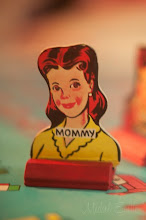The ISO Game Show:
Announcer: Welcome to the ISO Game Show! Ok folks on our left we have the LOW Family from Monkey's Eyebrow, KY and on our right is the HIGH Family from Saint-Louis-du-Ha! Ha!, Quebec. (We don't make this stuff up people.) Each family will be given stacks of blocks in all colors. Their job is to arrange the blocks on their sensor table to match the pattern they are shown on the big screen before you.
Ok Round One! On your mark. Get set. Go! The LOW family are surprisingly organized! Look at them go. The HIGH family is fast, but seem a little messy and less organized. Times up! Lets see how they did. Wow a perfect score for the LOW family! They matched every block correctly on their sensor table. The HIGH family did a fine job, but with some mistakes. Excellent job folks, but this round the points go to the LOW family.
Now time for round two. On your marks. Get set. Go! Ok they have a good start and, OH NO! The light is dimming on our monitor. What's happening? I do apologize, Folks. This is a big inconvenience. The contestants are stunned and time is running out. Keep playing! Can they do it? The LOW family is just standing there. I don't think they can see the screen. But look at that HIGH family! Wow, they are rushing and bumping into each other, but they seem to be putting something together. Time is up. Lets see how they did. The LOW family has....Nothing. Oh sorry! No points there. The high ISO family has....well it is the general pattern, but with some mistakes, still an unbelievable job for the HIGH family! ....
So what just happened? If you think of our camera like our eye. The light come in, shines on the back of the eye; there specialized cells interpret what we see and send that information to our brain. In the camera the light falls on either film or a sensor. The sensor can be made to react more quickly or slowly according by changing your ISO settings. In the case of the LOW ISO family above, in good light they provided the sensor with the most precise copy of what they saw, but couldn't see in the dark light. The HIGH ISO did not do as well, but they were able to work in darker lighting situation.
So just keep that in mind when you are taking photos. You want the clearest photo possible that a low ISO setting can give you, but when there is less available light high ISO can come to your rescue. You will sacrifice the possibility of adding grain the image. The higher the ISO the more grain. What setting number do you want to work with? Well it depends on your camera. The new digital cameras are reaching unreal ISO levels never achieved with film and are taking clearer photos at higher ISO's. My camera isn't one of those! I keep my camera at the lowest possible ISO. That is usually around ISO 100. My camera stinks at ISO 800, lets not even talk about ISO 1600, so I work hard to keep it as low as the camera will let me.
I know this is a very simplistic view of ISO. If you want more technical information Wikipedia offers wonderful articles explaining the mathematics of it all. I hope this helps people grasp a general understanding which will come together when we combine ISO, Shutter Speed, and Aperture to shoot manually. Also remember the above is the same concept for film. You can buy higher speed film for lower light situations. Also, the high shutter speed needed to capture fast action(sports) also lets less light in the camera, so a higher ISO is useful in fast action situations.
I apologize for the lack of photos in this article. I might add some examples of a grainy photo soon.
2010-08-05
Subscribe to:
Post Comments (Atom)





No comments:
Post a Comment